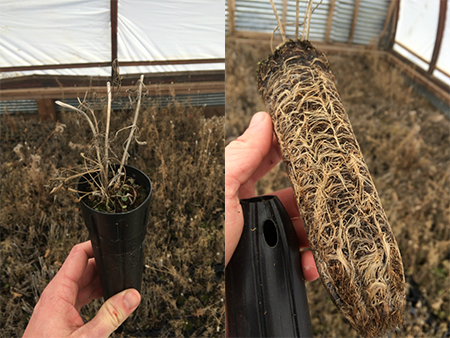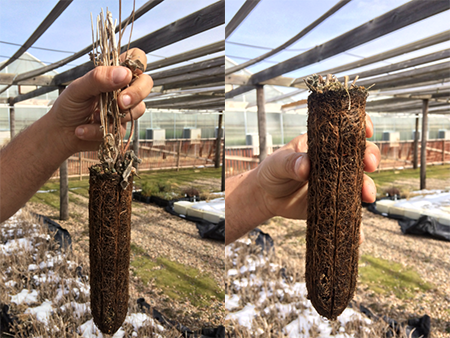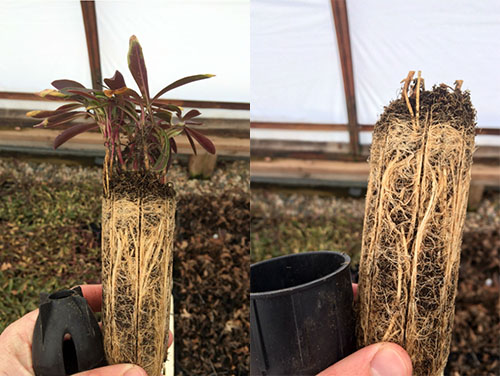Healthy Perennial Plant Material: A Focus on Root Systems
Wait! Don’t fret just yet. We promise, the perennials you have are alive and will be beautiful, soon!
 You may receive perennials from us that look much like the Yellow Prairie Coneflower on the left in the adjacent picture. We understand that it may bring a bit of concern to get plant material that looks like this.
You may receive perennials from us that look much like the Yellow Prairie Coneflower on the left in the adjacent picture. We understand that it may bring a bit of concern to get plant material that looks like this.
But, as we noted, fret not, this plant and your perennials will be big and beautiful come the right time of year (with proper care, of course).
What do I mean by right time of year?
Each perennial has a specific standard set of time that they come into full bloom, e.g., May through September. Before and after this time your perennials may very well look plain.
But, you ask, how do you know if you have viable plant material when it looks like this? The answer: the root system!
The image on the right side of the adjacent photo (same plant in both) highlights the type of root system that you want to see. This is the type of root system that indicates the plant is healthy. This plant will, given proper care, come to full bloom when the time is right.
So, Colorado State Forest Service Nursery, when are those times? When can I expect my plant material to bloom? We are glad you asked. We have made a chart of the bloom times of all the perennials we currently carry. Note that these are general times and your plant material may vary in bloom time.
| Jan | Feb | Mar | Apr | May | June | July | Aug | Sep | Oct | Nov | Dec | |
|---|---|---|---|---|---|---|---|---|---|---|---|---|
| Little Bluestem | X | X | X | X | X | X | X | |||||
| Blue Grama | X | X | X | X | ||||||||
| Switchgrass | X | X | X | X | ||||||||
| Leadplant | X | X | ||||||||||
| Gayfeather | X | X | X | |||||||||
| Milkweed | X | X | X | |||||||||
| Colo. Blue Columbine | X | X | X | |||||||||
| Black Eyed Susan | X | X | X | X | X | |||||||
| Yellow Prairie Coneflower | X | X | X | X | X | |||||||
| Purple Poppy Mallow | X | X | X | X | ||||||||
| Blanket Flower | X | X | X | X | ||||||||
| Rocky Mtn Penstemon | X | X | ||||||||||
| Wild Bergamot | X | X | X | X | X | |||||||
| Eastern Purple Coneflower | X | X | X | X | X | X | ||||||
| Lanceleaf Coreopsis | X | X | X |
More examples of healthy perennials

On the left side of the image above is an untrimmed Black-Eyed Susan that has beautiful root structure that will lend to the development of a beautiful plant. On the right side of the image is the same plant, but trimmed. The image on the right is indicative of what the perennial plant material is going to look like when it gets to you in the spring.

Lastly, you may be wondering why we bother trimming the perennials before we get them to you. It is, with full disclosure, for the benefit of you and the plant! The shipping process, at times, can be quite rough. As such, the plant is liable to get a bit damaged. So, the answer to this inquiry is that we trim them so that they do not get damaged in the shipping process.
As always, if you have any questions regarding perennials or any of our plant material, reach out to us at csfs_trees@mail.colostate.edu or give us a call at (970) 491-8429.
Happy perennial planting!

